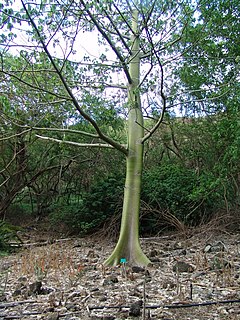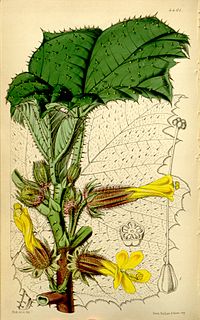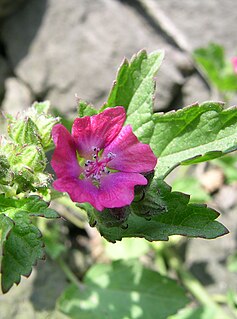
The genus Pulsatilla contains about 40 species of herbaceous perennial plants native to meadows and prairies of North America, Europe, and Asia. Derived from the Hebrew word for Passover, "pasakh", the common name pasque flower refers to the Easter (Passover) flowering period, in the spring. Common names include pasque flower, wind flower, prairie crocus, Easter flower, and meadow anemone. Several species are valued ornamentals because of their finely-dissected leaves, solitary bell-shaped flowers, and plumed seed heads. The showy part of the flower consists of sepals, not petals.

Althaea is a genus of herbaceous perennial plants native to Europe, North Africa and western Asia. It includes Althaea officinalis, also known as the marshmallow plant, whence the fluffy confection got its name. They are found on the banks of rivers and in salt marshes, preferring moist, sandy soils. The stems grow to 1–2 m tall, and flower in mid summer. The leaves are palmately lobed with 3–7 lobes. Althaea species are used as food plants by the larvae of some Lepidoptera species including Bucculatrix quadrigemina.

Malvaviscus is a genus of flowering plants in the mallow family, Malvaceae. Common names for species in this genus include Turk's cap mallow, wax mallow, sleeping hibiscus, and mazapan. It belongs to a group of genera that differ from the closely related Hibiscus in possessing a fruit divided into 5 separate parts, and having a style surmounted by 10, rather than 5, capitate or capitellate stigmas. Among those genera Malvaviscus is distinguished by having auriculate petals and red, fleshy fruits. The generic name is derived from the Latin words malva, meaning "mallow," and viscus, which means "sticky," referring to the mucilaginous sap produced by members of the genus. The fruit can be used to make jelly or syrup. Both the fruit and flowers are used to make herbal teas.
Bastardiopsis is a genus of trees in the family Malvaceae, containing the following species:

Pavonia is a genus of flowering plants in the mallow family, Malvaceae. The generic name honours Spanish botanist José Antonio Pavón Jiménez (1754–1844), as chosen by his contemporary, Spanish botanist Antonio José Cavanilles. Several species are known as swampmallows.

Rhodognaphalon is a genus of flowering plant in the family Malvaceae: found in tropical Africa.

Wercklea is a genus of flowering plants in the family Malvaceae.
Akrosida macrophylla, commonly known as the bigleaf akrosida, is a species of plant found in Brazil. It was first described by Oskar Eberhard Ulbrich, who called it Bastardia macrophylla.

Cienfuegosia is a genus of plants, in the family Malvaceae and placed in the tribe Gossypieae. Species can be found in central and south America, Africa including the Arabian peninsula.

Fuertesimalva is a genus of flowering plants in the mallow family Malvaceae, native to Mexico, Venezuela, Columbia, Ecuador, Bolivia, Peru and Argentina. Most species in this genus were originally placed in Urocarpidium.
Urocarpidium is a genus of flowering plants in the mallow family Malvaceae, native to the Andes mountains of South America. Many species originally placed in this genus were moved to Fuertesimalva in 1996.

Anemonastrum is a genus of flowering plants in the buttercup family Ranunculaceae. Plants of the genus are native to the temperate and subarctic regions of North America, Greenland, Europe, Asia, South America, and New Zealand. The generic name Anemonastrum means "somewhat like anemone", a reference to the Anemone genus of closely related plants. It chiefly differs from Anemone in having a base chromosome number of x=7, as opposed to x=8.

Acaulimalva is a genus of plants in the family Malvaceae. It contains 21 species that are found in South America.
Urophysa is a genus of flowering plants belonging to the family Ranunculaceae.
Anotea is a genus of flowering plants belonging to the family Malvaceae.
Batesimalva is a genus of flowering plants belonging to the family Malvaceae.
Billieturnera is a genus of flowering plants belonging to the family Malvaceae.
Briquetia is a genus of flowering plants belonging to the family Malvaceae.
Cephalohibiscus is a genus of flowering plants belonging to the family Malvaceae.









